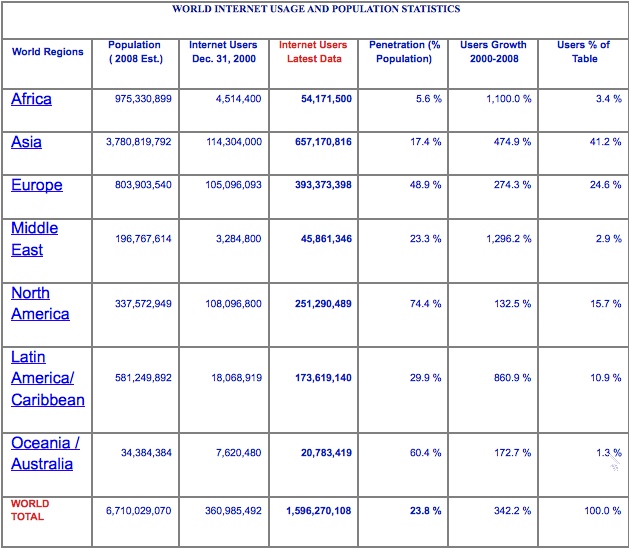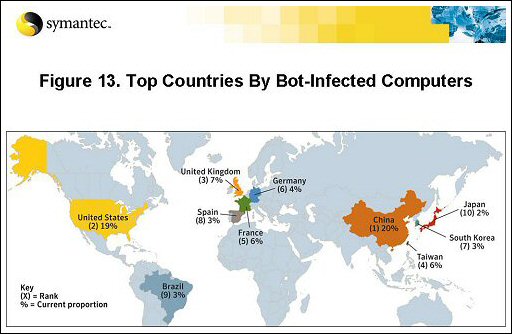Statistics of Internet Threats
From Computing and Software Wiki
Statistical Analysis of Internet Threats is a set of data which involves statistics from a range of different internet threats.
Contents |
Definition
An internet threat is any sort of intrusion to your local computer that comes from the internet. These threats can be a wide variety of threats such as spyware, malware, trojans, hacking, pop-up ads, local intrusion, and the list goes on.
Number of Users Online
The internet is being used by most countries today. The population that uses internet within those countries are about 20% compared to the whole population within that country. It is estimated that there are 6.7 billion people in this world and of that population 1.6 billion use the internet [1].
Penetrations by Population
Of all this internet access not everything is safe and secure. There are major issues of internet threats. The following table shows the penetration by population of Internet threats.

Top Countries Affected
All of the countries that have internet are exposed to internet threats. The following figure shows us the top countries affected by spam.

Statistical Analysis
It is said that 55% of online users today have been infected with spyware [2]. It is also stated that 89% of consumer PCs are infected by various types of spyware. The average American PC has over 30 different types of spyware on their machines [4]. There are many different kinds of spyware including malicious spyware such as Trojan. The percentages of Trojan spyware on PCs have been increasing over the quarters [4].
In 2006 0.3% of all queries returned by regular use of the internet were malicious content. That increased to 1.3% in the course of 1 year [5]. 75% of companies cited employees as the source of hacking. 45% of businesses had reported unauthorized access by insiders [6].
With the help of the San Fransisco FBI (Federal Bureau of Investigation) Computer Intrusion Squad on March 12, 2001, they were able to find some interesting statistics. Of 538 companies involved in the analysis, 85% of these companies have had a breach within the last 12 months. 64% of these companies acknowledge financial losses due to computer breaches. 70% of these companies believe the internet as the source of attacks, where as 30% believe internal workers as the source of attacks [7].
Conclusion
As a result, we can clearly see that all countries from any continent are affected by internet threats. The threats are decreasing as well as increasing. Older threats are being fixed but new threats keep rising. The rise in threats is greater than the decrease in removing threats. Thus we can conclude with the statistics that internet threats are still an issue today. They can be harmless spam or can be dangerous viruses stealing personal information. People today need to put more emphasis on security for personal or corporate use.
See Also
[Public Key Authentication]
[Not Filled out yet]
[Not Filled out yet]
[Not Filled out yet]
[Not Filled out yet]
External Links
%%--//Internet World Stats
Security Statistics
History of the Internet Security Threat Report
State of Spyware Q2 2006
Website Security Statistics (August 2008)
Key Internet Usage Statistics
General Information Security Statistics
References
- Internet World Stats Retrieved April 2, 2008, from http://www.internetworldstats.com/stats.htm
- Security Statistics Retrieved April 2, 2008, from http://www.esafe.com/home/csrt/statistics/statistics_2005.asp
- History of the Internet Security Threat Report Retrieved April 2, 2008, from http://www.conferencepage.com/ISTR0409/HistoryofThreatReport.shtm
- State of Spyware Q2 2006 Retrieved April 2, 2008, from http://www.webroot.com/resources/stateofspyware/excerpt.html
- Website Security Statistics (August 2008) Retrieved April 2, 2008, from http://www.slideshare.net/jeremiahgrossman/website-security-statistics-august-2008-presentation
- Key Internet Usage Statistics Retrieved April 2, 2008, from http://www.3w.net/lan/internet-use-statistics.html
- General Information Security Statistics Retrieved April 2, 2008, from http://www.securitystats.com/infosec.html
--Jeff Takeda Takedaj 12:19, 9 April 2, 2008 (EST)
